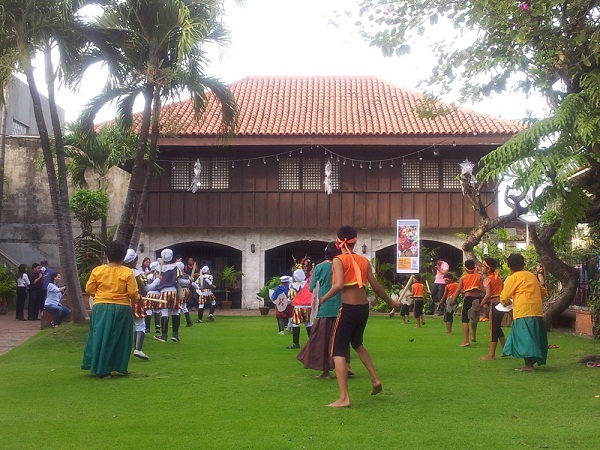‘Sinug’ as dance of faith and culture

MEMBERS of the Turang Dance Troupe dance the traditional prayer-dance for the Sto. Niño during the annual Sinug sa Casa Gorordo in Cebu City on Jan. 21. Photo by Cris Evert Lato
CEBU CITY—She just closed her eyes the entire time, but not even her frail figure could stop the oldest Sinulog dancer and “heritage keeper” from attending the annual prayer-dance held on Jan. 21, a day after the Feast of the Holy Child Jesus in Cebu, at Casa Gorordo Museum on Lopez Jaena Street in Cebu City.
Instead of beating drums and leading a group of dancers and visitors in performing the Sinug, Estelita “Inday Titang” Diola, 87, was in her wheelchair, her head supported by a pillow. Her grandson, Rommel Borja, led the Turang Dance Troupe of Barangay Mabolo for the annual “Sinug sa Casa Gorordo.”
Although her eyes were closed the whole time, Borja said she was praying with them during the entire ritual.
“We made sure she is here. We do not know—this might be her last. Her presence here, even if she is not dancing anymore, tells people that the authentic Sinulog will live because we are here to continue the tradition,” said Borja, 40, who was trained by Inday Titang as early as 3 years old.
On Jan. 23, Inday Titang was brought to the government-run Cebu City Medical Center (CCMC) for pneumonia.
Article continues after this advertisementBorn in 1926, Inday Titang started dancing the Sinug, a traditional prayer-dance offered to the Sto. Niño de Cebu, when she was 7 years old.
Article continues after this advertisementHer father, Buenaventura “Turang” Diola, taught her the steps and how to sing the songs. From a relative, Macario “Iklot” Bontilao, she learned the “sinug” beat using a drum wrapped with goatskin.
Both Turang and Iklot belonged to a loose dance group called Mabolo Tribe which joined the Sinug dancing. Other members included Turang’s wife Nasaria and children—Mateo, Eduarda, Lucia, Romana and Inday Titang.
The Diolas are devotees of the Sto. Niño.
Turang worked as a “kuchero” for the Gorordo family and was asked by the family to perform the ritual the Monday after the feast day of the Holy Child, which falls every third Sunday of January.
It was the tradition of the Gorordo family and other households in Barangay Parian in Cebu City to have Sinug dance troupes perform on Mondays after the Fiesta Señor as a prayer for the souls of their departed loved ones, according to Ramon Aboitiz Foundation Inc. (Rafi). Mondays are considered to be the day of souls by Roman Catholics, especially those in purgatory.
Rafi has continued the tradition when it assumed management of Casa Gorordo and opened it as a museum in 1983. The annual event is dubbed “Sinug sa Casa Gorordo.”
In the past years, Inday Titang had led the prayer-dance. She would beat the drum and hold a wooden spear while dancing. In December last year, she fell and hurt her right hip inside her house in Barangay Mabolo.
On Dec. 27, she developed a fever and complained of swelling and intense pain in the right leg. Four days later, she was brought to CCMC where doctors diagnosed her to be suffering from cellulitis and swelling of the skin and tissues. She was discharged from the hospital in January.
During the Sinug sa Gorordo, Borja took the place of Inday Titang and led the prayer-dance joined by at least 30 people of different ages, including Argie de los Santos, 6, Leonardo Macbride Boticario, 8, and Jeffrey Jakosalem, 13. It was Jeffrey’s second time to join the troupe while Argie and Macbride were both first-timers.
“We don’t know what the Latin songs mean exactly, but we were told by Inday Titang before that these are offerings to the Sto. Niño—that if you pray sincerely and you do your part, He will grant your wish,” Jeffrey said.
The dancers wore simple costumes sewn by Borja, a carpenter.
The sound of the drums was the only accompaniment as they performed the natural and kinampilan steps. The natural step is the popularly known two-steps-forward, one-step-backward routine. The kinampilan has one step right forward and one step backward while the left foot stays in place.
The dance has three main characters—the Christians (dressed as “conquistadores”), the Muslims (dressed in precolonial costumes) and the Batang Hari or Holy Child. Its story usually revolves around the war between the Christians and the Muslims and how the Holy Child brought peace to them.
Dr. Jocelyn Gerra, Rafi executive director of the culture and heritage program, invited everyone to join in the dancing. She said it was important for regular people to be aware of this tradition as one of the bases for Filipino cultural identity.
Papers were circulated to onlookers, who would like to include the names of their departed loved ones in the prayer-dance.
Gerra said the “Sinug sa Casa Gorordo” was not an event but a solemn gathering where people could write their petitions and have them read during the prayer-dance.
“We would like to let people know that we pray when we do this dance. This is not just a performance. It tells us of our faith and our culture,” she said.
To preserve the tradition, Casa Gorordo curator Florencio Moreño II said a workshop was being organized so that more people could learn the traditional dance steps.